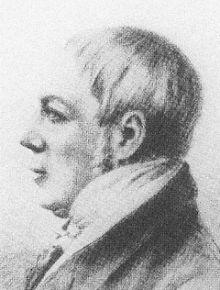William Hedley
William Hedley | |
|---|---|
 | |
| Born | 13 July 1779 Newburn, England |
| Died | 9 January 1843 (aged 63) |
| Nationality | British |
| Occupation | Colliery viewer |
William Hedley (13 July 1779 – 9 January 1843
Early locomotives
Before Hedley's time, such locomotives were far too heavy for the track that was then available. While most lines used cable haulage with stationary engines, various other schemes had been tried. William Chapman at the Butterley Company in 1812, attempted to use a steam engine which hauled itself along a cable, while, at the same company, Brunton had produced the even less successful "mechanical traveller", or Steam Horse.
However, in 1812,
Hedley's improvements
First locomotive
Hedley felt that if the pairs of wheels were connected, as with
Puffing Billy and Wylam Dilly
He built a second engine, with the assistance of the, later to be famous,
Modifications
However, there was still considerable wear to the track, and the engines were rebuilt using twin four-wheeled bogies, introduced in Blackwell's design mentioned above. Initially the wheels were without flanges for use on the flanged plate rails. In about 1830 the line was relaid with the stronger edge rails, and both locomotives reverted to their original pattern, but with flanged wheels, which is how they are today. Both locos remained in active service until 1862.
Death
Hedley died in 1843 at Burnhopeside Hall, near Lanchester and was buried at Newburn parish church. Four sons survived him and his descendants remained heavily involved in the coal-mining industry until nationalisation in the 1940s. In 1971, a charitable foundation was set up in the Hedley name, with assets based on the compensation from nationalisation.
References
- Ransom, P.J.G. (1990). The Victorian Railway and How It Evolved. London: Heinemann.
- ^ "William Hedley - Britannica Online Encyclopedia". Retrieved 2007-01-04.
Further reading
- Kirtley, Allan, Longbottom, Patricia, Blackett, Martin (2013). A History of the Blacketts. (2013) The Blacketts. ISBN 978-0-9575675-0-4. Archived from the original on 2014-06-23.)
{{cite book}}: CS1 maint: multiple names: authors list (link
External links
